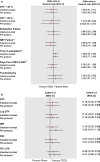Transcutaneous electrical diaphragmatic stimulation in mechanically ventilated patients: a randomised study
- PMID: 37649092
- PMCID: PMC10469422
- DOI: 10.1186/s13054-023-04597-1
Transcutaneous electrical diaphragmatic stimulation in mechanically ventilated patients: a randomised study
Abstract
Background: Few specific methods are available to reduce the risk of diaphragmatic dysfunction for patients under mechanical ventilation. The number of studies involving transcutaneous electrical stimulation of the diaphragm (TEDS) is increasing but none report results for diaphragmatic measurements, and they lack power. We hypothesised that the use of TEDS would decrease diaphragmatic dysfunction and improve respiratory muscle strength in patients in ICU.
Methods: We conducted a controlled trial to assess the impact of daily active electrical stimulation versus sham stimulation on the prevention of diaphragm dysfunction during the weaning process from mechanical ventilation. The evaluation was based on ultrasound measurements of diaphragm thickening fraction during spontaneous breathing trials. We also measured maximal inspiratory muscle pressure (MIP), peak cough flow (PEF) and extubation failure.
Results: Sixty-six patients were included and randomised using a 1:1 ratio. The mean number of days of mechanical ventilation was 10 ± 6.8. Diaphragm thickening fraction was > 30% at the SBT for 67% of participants in the TEDS group and 54% of the Sham group (OR1.55, 95% CI 0.47-5.1; p = 0.47). MIP and PEF were similar in the TEDS and Sham groups (respectively 35.5 ± 11.9 vs 29.7 ± 11.7 cmH20; p = 0.469 and 83.2 ± 39.5 vs. 75.3 ± 34.08 L/min; p = 0.83). Rate of extubation failure was not different between groups.
Conclusion: TEDS did not prevent diaphragm dysfunction or improve inspiratory muscle strength in mechanically ventilated patients.
Trial registration: Prospectively registered on the 20th November 2019 on ClinicalTrials.gov Identifier NCT04171024.
Keywords: Diaphragm dysfunction; Electrical stimulation; Intensive care unit; Mechanical ventilation.
© 2023. BioMed Central Ltd., part of Springer Nature.
Conflict of interest statement
The authors declare that they have no competing interests.
Figures



References
Publication types
MeSH terms
Associated data
LinkOut - more resources
Full Text Sources
Medical

